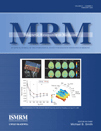Axial black blood turbo spin echo imaging of the right ventricle
Abstract
Black blood turbo spin echo (TSE) imaging of the right ventricle (RV) free wall is highly sensitive to cardiac motion, frequently resulting in nondiagnostic images. Temporal and spatial parameters of a black blood TSE pulse sequence were evaluated for visualization of the RV free wall. Seventy-four patient studies were retrospectively evaluated for the effects of acquisition timing on image quality. Axial black blood TSE images were acquired on 10 healthy volunteers to assess the role of spatial misregistration on right ventricle visualization; increasing the double inversion recovery (DIR) slice thickness beyond 300% had no effect on image quality (P = 0.2). Thirty-five patient studies were prospectively evaluated with inversion times (TIs) corresponding to the mid-diastolic rest period and end-systole based on visual analysis of a four chamber cine. When TIs were chosen to be within the patients' RV rest period, mean image quality score was significantly improved (2.3 vs 1.86; P < 0.001) and the number of clinically diagnostic images increased from 32% to 46%. Black blood TSE imaging of the RV free wall is highly sensitive to cardiac motion. Image quality can be improved by choosing TIs concordant with the rest period of the patient's RV that may occur at mid-diastole or end-systole. Magn Reson Med 61:307–314, 2009. © 2009 Wiley-Liss, Inc.




